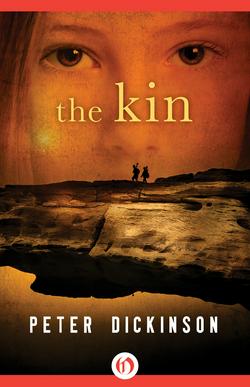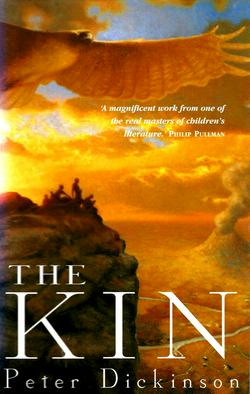

The Kin
About the Book
The adventures of four early human children, just after the development of spoken language. The group to which they belong has been driven from its ancestral lands and has to travel through unfamiliar terrain in search of somewhere else to live. (Illustrated by Ian Andrew. Originally published in the US as four linked novels, Suth, Noli, Po, and Mana, but in the UK as a single volume, The Kin, and later as four separate paperbacks.)
Author Comment
Though I now think of the single-volume edition of this as one of my more satisfactory books, I almost didn’t write it at all. Judy Donnelly, a New York editor who I’d never worked for, had enjoyed A Bone from a Dry Sea, so when she asked my London agent if I’d write three shorter books for younger kids on the same kind of theme. I wasn’t keen - I felt I’d already done as much as I wanted about that. I didn’t want to get labelled as a chimp-and-early-human specialist. But my previous adult novel had gone irretrievably off the rails, and though I was now working on another one money was suddenly short. My agent said “What about Judy’s offer? I think I can talk her up.” The talking-up turned the three books into four with a generous advance, but I said I didn’t want the money or a contract till I’d done enough to show Judy a brick, so that she could see what the finished house might be like, and also to persuade myself that the thing was possible. My brick became the first few pages of Suth. Meanwhile my long-time London publisher, Gollancz, having been swallowed some years earlier by a larger firm, found themselves merged with a yet larger one who weren’t interested in doing kidbooks. Without consulting any of the authors they sold their list, lock, stock and barrel, to a fourth publisher. I was miffed, to say the least, so my agent said “No thanks” for me and sent my brick to Marion Lloyd at Macmillan. Marion, with very little to go on as far as I could see, decided that she had something special on her hands, which might win the Carnegie Medal. She wanted to start with a single big blockbuster volume, lavishly produced, and only later come out with the four separate sections as paperbacks. I was dead against this. It wasn’t what I had in mind, I’d no idea what was going to happen in the remaining three sections, my confidence had been badly shaken by what had happened with my earlier adult novel, and I wanted to get on with my new one. Besides, I wasn’t even sure that I could finish the project, and as for winning the Carnegie, that was cloud-cuckooland. But in the end I gave in. Though I’d begun Suth as a pot-boiler, after the first three or four chapters I became interested in what I was doing for its own sake. I rewrote it with increasing excitement about the possibilities that lay ahead, though I still had very little idea about what was actually going to happen. There were already five main characters. Four of them would in turn provide the viewpoint figure of each of the books. Suth had already emerged as the practical one, and Noli the visionary, so Po was going to be the boy with dreams of glory, which left Mana to be the homebody. Tinu, the fifth, was the shy and inarticulate genius. (Po, by the way, became Ko in England, to avoid confusion with the Teletubby. Dumb, I thought, but I decided I preferred Ko anyway.) My only other briefing from Judy had been “Short sentences and lots of adventures.” With five stock central characters this doesn’t sound like the recipe for a novel of much depth or richness, but almost at once fascinating possibilities emerged. I didn’t want to repeat what I’d done in A Bone from a Dry Sea, so I chose a period early in the development of language. There were a variety of non-speaking but otherwise human-like creatures around at this time. In the very first chapter, solely to get the story going, Noli had had a dream in which the group’s totemic spirit had appeared to her and told her to leave the others and go back and rescue some children who’d been left behind. Again, just to deal with the obvious question of what this totem represents, I’d interspersed the people’s own Creation-and-fall myth between the chapters of adventures. I wanted to know how my characters thought and felt and believed. I became aware that though they seem to us to come almost at the beginning of human history, they are in their own minds the inheritors of a rich oral tradition going back unknown generations. As they move into new territory (which I had them do primarily to increase adventure-possibilities) they meet some of the non-speakers and, since for them speech is what distinguishes people from animals, they have to face the question of whether these creatures are indeed fellow humans. All this — the nature of language, the early stirrings of religion, the structure of societies, our separateness from other animals, and so on — may seem more than enough for an adventure novel to digest, but I didn’t have to work it in. Almost all my attention was engaged in getting my characters from one adventure to the next, and then making the adventures work, but with little effort on my part these themes threaded tactfully in, providing a kind of moral girderwork to support the surface excitements. And at the same time what I continued to think of as four separate books (which they were still going to be in the US) somehow developed a coherent drive and architecture. This, together with my own unawareness that it was happening, is epitomised for me in the last four words of the book, which seem to sum the whole thing up, and be the point for which I had been aiming all along. I thought of them only five or six pages before I reached them. Half way through, though we were all anxious for me to get on with the job, I decided that my appetite for short sentences had become jaded, so I took three months off to rewrite the novel that became Some Deaths before Dying, and then came back The Kin with renewed energy. This was just as well because Marion had discovered that the book wouldn’t be eligible for the Carnegie if any part of it had been published abroad more than three months before it was available here. The Americans were still aiming to publish the four sections separately and were almost ready to go with Suth. Generously, they delayed their publication date for a month to help. Marion advanced hers by a year. I decided I could just about cope with that, and in fact finished with time to spare. It was all there, waiting to come. (In the fifty-odd books I’ve written this has only happened to me once before, towards the end of Heartsease. Normally I’m a steady accumulator, not a streamer-out.) I wrote the Mana section in six weeks, some of the chapters on holiday with the family. They went exploring, while I sat in our room all morning, tapping away on my little Olivetti. Well, we made it. The book looked marvellous, with wonderful illustrations by Ian Andrew. It had great reviews, sold well, and got on the Carnegie short list, though it didn’t win. (I’ve had nine books on the short list over the years, and this was the only time I truly minded not winning.) Its fate in the US couldn’t have been more different. A few years ago I was sent proofs of my entry for one of the Gale Research reference books about Children’s Literature. It included a supposedly complete bibliography and a several-page essay on my work. Neither even mentioned The Kin. Almost from the moment of their publication the books had virtually disappeared. I suppose the four-volume format was mainly to blame for this, combined with the less-than-striking appearance of the books themselves. And the fact that Judy Donnelly had lost her job in yet another of those publishing upheavals (I had four separate publishers shot under me in the space of a few years) cannot have helped. Though she stayed on in an advisory role and did a marvellous job editing the book (by the end of the process both Marion and Judy seemed to know it far better than I did) it had always been very much her book, and maybe she no longer had the kind of leverage inside the organisation to help it along. And then a wonderful thing happened. I was at the American Library Association conference in Atlanta, because The Ropemaker was a runner-up for the Prinz Prize. Nancy Paulsen of Penguin Putnam had recently published Water and I did a signing session for her. I’d forgotten that Penguin Putnam were the firm that had swallowed my original publishers, so I told her with no ulterior motive about my disappointment over the US version of The Kin. It turned out that she’d already been thinking about having another go at it, and then several librarians showed up at my table with copies of the Macmillan edition for me to sign, bought on Amazon UK. By the end of the session it seemed almost settled that Nancy was going to re-issue it in that form, and put an effort behind it so that it didn’t seem merely a re-issue. And then, lo and behold, it happened. I was as pleased as Punch.
Awards
Carnegie Medal shortlist - 1998
Reviews
An epic reconstruction of the dawn of humankind.
Times Educational Supplement (11 May 2008)
It is a remarkable work. Not only is there a thrilling sweep of ideas and images; Dickinson has also created a completely believable and compelling culture and history from a period which has left virtually no traces..
Daily Telegraph
Publishers
Macmillan, UK - 1998
Putnam, US - 1998
Open Road, US - 2015
